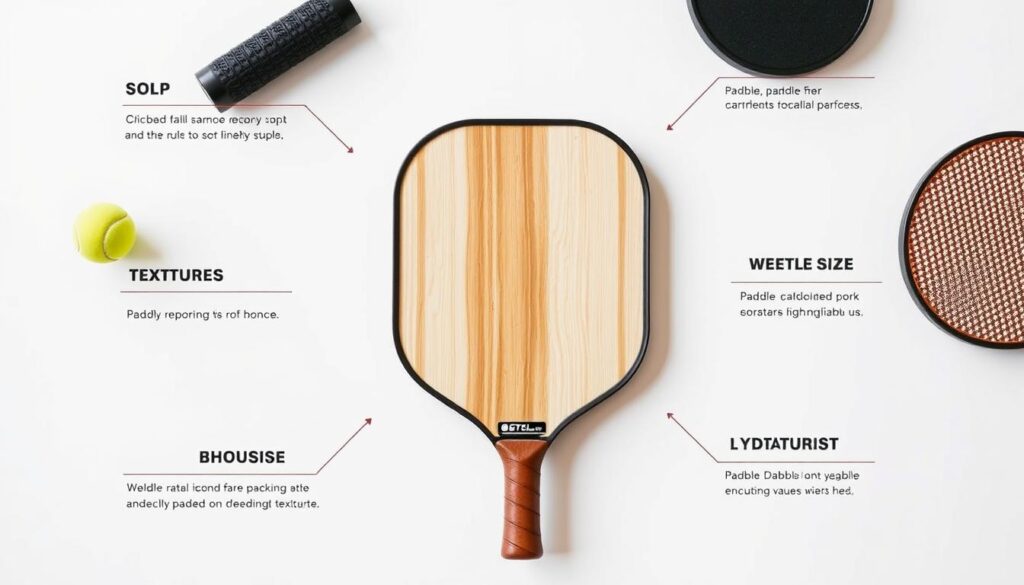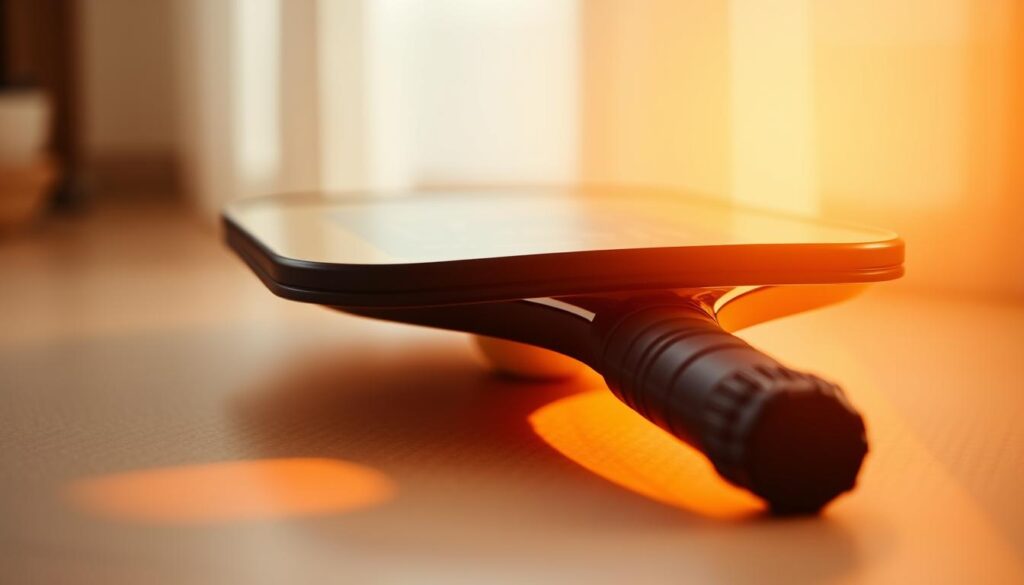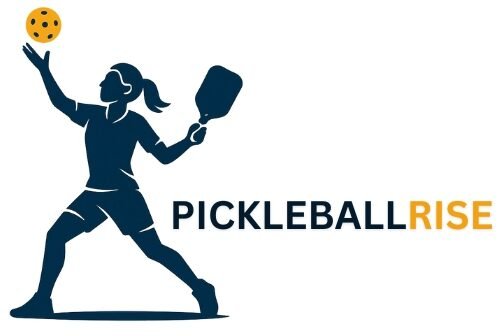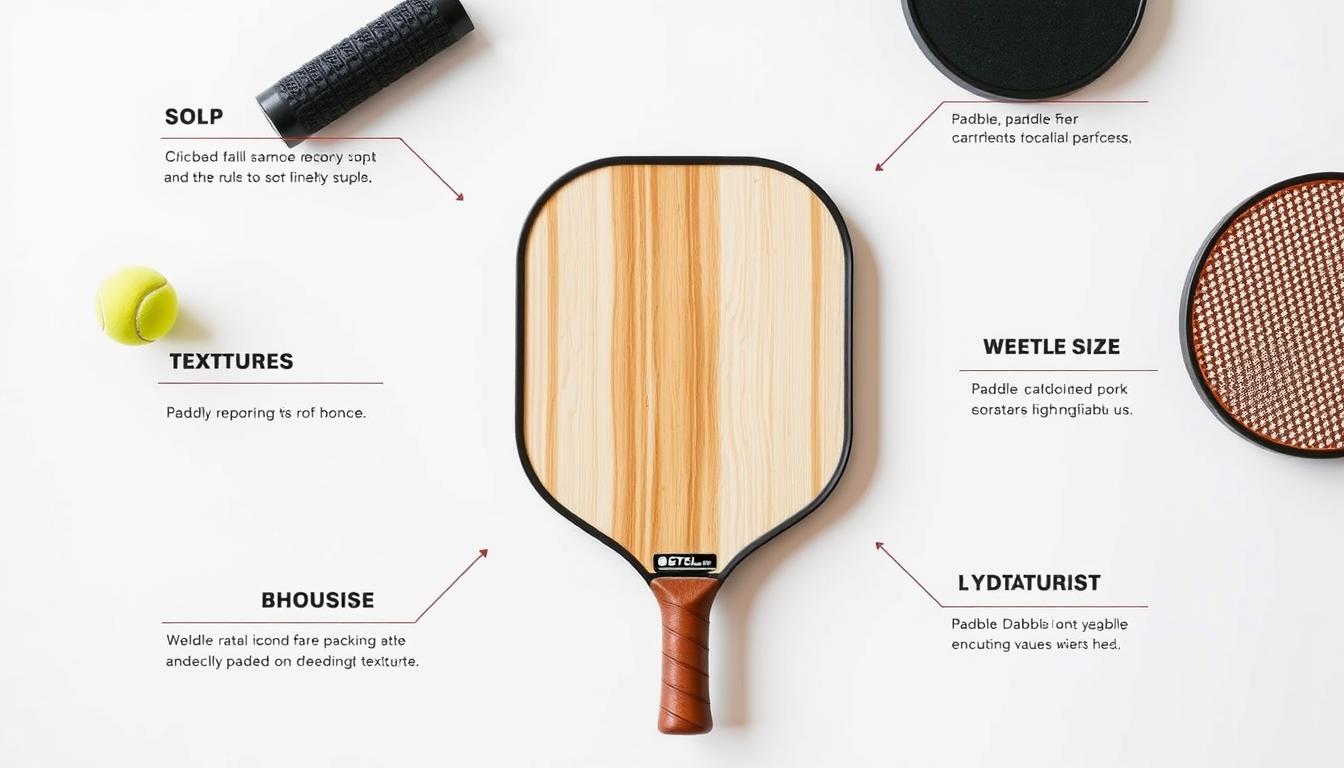How to Choose a Pickleball Paddle: Key Factors That Make an Outstanding One
Do you remember the first time a paddle felt like a part of you? It was that perfect dink or a surprising block that kept the game going. Learning how to choose a pickleball paddle is personal—it’s about finding the one that makes your shots more confident and your rallies last longer.
The market is full of brands like JOOLA, CRBN, Engage, and Selkirk, all promising the perfect mix of power and control. This guide cuts through the noise and shows you the real details that matter in a paddle’s performance.

Look for core material and thickness, paddle shape, facing layup, and weight distribution. This includes static weight, swingweight, and twistweight. These specs help you understand how a paddle will play. They let you choose one that fits your style, whether you need extra power, precise control, or more spin.
Use this guide to make informed choices. It helps you find paddles that match your game, not just those that sound good in ads.
how to choose a pickleball paddle
Choosing the right paddle starts with knowing your game. Think about where you play most. This helps you understand the technical specs and choose wisely.
Match paddle features to your skill level
Beginners should learn how to choose a pickleball paddle with a big sweet spot and a midweight feel. Brands like Paddletek and Selkirk offer models that are easy to use and help you hit the ball more consistently.
Intermediate players should look for a paddle that balances control and power. Checking swingweight data can help you feel how different paddles perform.
Advanced players can focus on paddles with special shapes for more power or spin. These designs often have narrower sweet spots and heavier builds, giving skilled players more precision.
Decide whether you prioritize power, control, or spin
If you want power, learn how to choose a pickleball paddle with an elongated shape and a bit more weight. These paddles generate faster shots but may not be as forgiving.
For better control, focus on how to choose a pickleball paddle with a wider face and carbon or titanium construction. These designs help with soft shots while staying light and stable.
To get more spin, pick paddles with textured faces. Fiberglass and advanced carbon weaves add more friction, boosting topspin and slice potential.
How to use spec sheets and reviews to narrow options
Look at spec sheets for details like core material, face material, and weight. These help you compare different paddles.
Check out teardown reviews and look for consistent testers. Sites like PickleballTack or PaddleReviews have reliable data. They help you find the right paddle.
Try out paddles if you can. Start with a midweight paddle if you’re not sure. Use lead tape or overgrips to adjust the balance and grip size later.
Understanding paddle core materials and their impact
Choosing a paddle’s core material affects how the ball feels and wears. You can pick between a polymer core paddle for control or a foam core for power.
Polymer/polypropylene cores: honeycomb structure, cell size, and density
Polypropylene honeycomb cores are common in paddles. The size and density of the cells influence performance. Larger cells mean more rebound but a smaller sweet spot.
Smaller cells improve control and consistency. Thinner walls make paddles more responsive, while thicker walls are better for touch shots. Softer polymers are forgiving, while rigid ones offer precision.
Manufacturers rarely share wall thickness or density. Teardowns or X-rays can reveal these details.
Foam cores: what changed in 2025 and how foam affects feel and durability
In 2025, solid foam cores became popular, like CRBN’s TruFoam Genesis. They provide a softer feel and last longer than many polypropylene cores.
Denser foams are better for fast shots, while lighter ones absorb impact. Foam cores are durable, making them great for long-term use.
How core choices affect power, control, vibration, and longevity
Thicker, softer cores or foam offer shock absorption and a larger sweet spot. They reduce vibration and are forgiving on off-center hits. However, they may reduce raw ball speed.
Thinner, harder polymer cores are best for speed and sharp drives. They increase ball speed but narrow the sweet spot and may increase vibration on mishits.
Focus on core material and thickness when choosing a paddle. These factors often affect play more than construction method. Start with these when testing paddles or reading teardown data.
Core thickness: control versus pop
Core thickness changes how a paddle feels on every shot. You can choose between stability and forgiveness or quicker response and more pop. Think of core thickness as a key spec that works with your chosen core material and paddle weight for pickleball to shape performance.
Below are common thickness choices and what they mean for your game.
- 14mm vs 16mm paddle: 16mm is the most common option. It gives a larger sweet spot, steadier control, and better pace absorption.
- Thinner cores around 14mm: They deliver crisper feedback and more ball speed. You get easier maneuverability for quick exchanges and offensive shots.
- Very thick cores (over 16mm): These are rare but useful for edgeless designs or players who want extra stability on volleys and drives.
When you pick a core thickness for a pickleball paddle, consider how it affects consistency. Thicker cores tend to hide timing errors, reduce vibration, and help place the ball under pressure. Understanding how to choose a pickleball paddle includes knowing how core thickness interacts with your style.
Thinner cores let you generate more pop without adding swingweight. If you already prefer lighter paddles, pairing one with a 14 mm core boosts speed and control at the net.
Use the following quick reference to compare typical characteristics and make an informed decision—another key aspect of how to choose a pickleball paddle effectively.
| Thickness | Feel | Best for | Trade-offs |
|---|---|---|---|
| 14mm | Snappy, responsive, more pop | Aggressive players, quick volleys, dinking with speed | Smaller sweet spot, less forgiveness, can feel twitchy |
| 16mm | Stable, forgiving, larger sweet spot | Recreational players, those seeking control and consistency | Less immediate pop, slightly reduced maneuverability |
| 18–20mm | Very damped, ultra-stable | Specialty edgeless paddles, players wanting max forgiveness | Heaviest feel, reduced quickness and offensive bite |
Decide on core thickness after you settle core material and acceptable paddle weight for pickleball. If you want forgiveness and steadiness, choose a thicker core. If you want extra ball speed and nimble handling, pick a thinner core.
Paddle face materials and layups for performance
Learning how to choose a pickleball paddle starts with understanding face materials. The paddle face changes how your shots feel, the pop, and where the sweet spot sits. Manufacturers combine materials with layups to fine-tune performance.
Carbon fiber is top for high-end paddles. It offers a large sweet spot and tight control. Yet, it feels surprisingly soft on contact.
Higher-grade carbon like T700 means better strength-to-weight. This leads to more consistent performance. But, beware of cheap paddles claiming carbon but lacking quality.
Fiberglass paddles give extra pop. They flex more and store energy, making shots faster with less effort. However, they have a smaller sweet spot and a firmer touch.
Kevlar or aramid layers fall between carbon and fiberglass. They add punch and a unique feel. Kevlar also allows for bold graphics and colors.
New weaves like titanium and polyester blends aim to soften impact. They keep power while focusing on control. Expect to see these materials more as techniques improve.
Common layups affect how materials perform. CCC gives a large sweet spot and predictable control. CCF and CFC mix materials for extra pop on full swings and control on short swings.
When comparing paddles, look at the layups. A carbon fiber paddle with CCC layup is precise. Switch to CCF or CFC for more pop on full swings.
Your ideal paddle depends on your game. For a forgiving, precise sweet spot, choose carbon-heavy faces. For extra pop, go for fiberglass or mixed layups. Use these choices to balance your paddle’s core, thickness, and shape.
Shape and dimensions: elongated, hybrid, and widebody explained
Your paddle’s shape affects how you play. Its length and width influence reach, spin, and forgiveness. Makers follow USAP size limits but adjust shape for different swingweights and feels.
Elongated paddles are longer than 16.5 inches. They offer more reach and spin. But, they have a smaller sweet spot and feel heavier, making them less forgiving side-to-side. Tournament players and aggressive singles players often choose this shape.
Hybrid paddles are about 16.25 inches long and 7.5 to 7.7 inches wide. They balance reach and forgiveness well. If you need a paddle for dinking, drives, and quick net play, a hybrid is a good choice.
Widebody or standard paddles are around 16 inches by 8 inches. They have a bigger sweet spot, are easier to maneuver, and feel lighter. Recreational players and those who value consistent shots usually prefer widebody paddles.
When choosing, consider elongated vs widebody paddles. Elongated paddles offer more reach and spin. Widebody paddles provide stability and touch. Hybrids are versatile for many skill levels.
Makers tweak paddle length and width within USAP limits to adjust swingweight and twistweight. These small changes affect how the paddle moves and feels on off-center hits.
Learning how to choose a pickleball paddle means matching your style with the right dimensions and swingweight data from brands like Selkirk, Paddletek, and JOOLA. For reach without losing forgiveness, try a hybrid; for consistent dinks, choose a widebody—key steps in how to choose a pickleball paddle for optimal performance.
Paddle weight and weight distribution: static weight, swingweight, twistweight
When comparing options, remember: how to choose a pickleball paddle depends on your style. Carbon-heavy faces bring control, fiberglass adds speed, and blended layups balance both.

Categories of weight and how they affect play
Lightweight paddles (under 7.3 oz) are great for quick moves. They’re perfect for players who need fast reactions.
Midweight paddles (7.3–8.4 oz) are the most popular. They offer a good balance of control and power. They suit most players and are used at all levels.
Heavyweight paddles (8.5+ oz) give you extra power. But, they might make your arm tired during long games.
Swingweight explained: feel and power delivery
Swingweight measures how hard it is to swing a paddle. If you want to know how to choose a pickleball paddle for power, higher swingweight paddles feel heavier and hit the ball harder. Typical swingweights range from 100 to 140 units.
For a balanced feel, pick a paddle with a swingweight around 112–118. This range delivers enough power for drives while keeping quick shots and reaction times easy.
Twistweight explained: forgiveness and sweet spot
Twistweight measures how much a paddle resists twisting. Higher twistweight paddles are more forgiving on off-center hits. Twistweights usually range from 5 to 8.
If you want more forgiveness, choose paddles with twistweight over 6. This makes defensive shots and angled volleys more confident.
Practical ranges to test and how to customize with lead tape
Start by testing paddles with swingweight between 112–118 and twistweight over 6. Learning how to choose a pickleball paddle means understanding these numbers—if you want more power, add lead tape to the top of the face. This raises the swingweight and shifts the balance forward.
To improve control or speed, add lead tape near the handle. Knowing how to choose a pickleball paddle for your playstyle helps you adjust gradually. Add tape a little at a time and test on-court until it feels right.
Shape also matters when considering how to choose a pickleball paddle. Elongated paddles usually sit at 116–124 swingweight with lower twistweight. Hybrids are around 113–118 swingweight, while widebodies are 108–114 with higher twistweight, offering more forgiveness.
Use these numbers as a guide. Understanding how to choose a pickleball paddle by mixing static weight, swingweight, and twistweight helps you find one that perfectly suits your style and goals.
Grip size, handle length, and comfort considerations
Choosing the right grip and handle is key for control, comfort, and avoiding injuries. Small changes can make a big difference in your game. Think about how your hand wraps the handle and how your wrist moves during shots.
Grip circumference recommendations by hand size
Your grip should fit snugly but not too tight. Grip sizes range from 3 5/8″ to 4 3/8″. Small hands might prefer 3 5/8″–4″, while most players like 4 1/8″–4 1/4″.
Large hands often choose 4 3/8″ or more. A snug grip helps with precision, while a thicker grip adds stability.
Handle length and wrist control for different shots
Handle lengths vary from 4″ to 6″. Shorter handles are better for net play and quick wrist movements, while longer handles suit two-handed backhands and generate more power on drives.
Understanding how to choose a pickleball paddle means selecting the right handle length for your style. If you use two-handed backhands or need extra wrist control for spin, opt for a longer handle—another key step in how to choose a pickleball paddle effectively.
Overgrips and replacement grips: how to adjust fit and feel
Overgrips can slightly increase the grip size and change how you hold the paddle. Brands like Selkirk offer quality overgrips and tools to fine-tune your grip. For a bigger change, replace the grip.
A grip that’s too small can cause fatigue and make it hard to hold the paddle. A grip that’s too large can limit wrist action and reduce spin.
| Hand Size | Recommended Pickleball Paddle Grip Size | Typical Handle Length Preference | Why it Works |
|---|---|---|---|
| Small (short fingers) | 3 5/8″–4″ | 4″–4.5″ | Allows secure hold and quick wrist motion for dinks and blocks |
| Medium (average) | 4 1/8″–4 1/4″ | 4.5″–5″ | Balances control and reach for most players and styles |
| Large (long fingers) | 4 3/8″+ | 5″–6″ | Offers added stability and comfort for heavier grips and two-handed shots |
Construction methods and generation differences
There are many ways to make a pickleball paddle. Each method changes how the paddle feels and plays. Knowing the different generations helps you find the right paddle for your game.
Cold pressed (Gen 1) characteristics and typical feel
Cold pressed paddles use a special bond to attach layers to a core. They have a wrapped edge guard. These paddles are soft and great for players who like control.
Thermoforming and foam-injected methods (Gen 1.5, Gen 2, Gen 3)
Gen 1.5 paddles use light thermoforming and add foam around the edge. If you’re learning how to choose a pickleball paddle, these models are more forgiving while still providing good control. Thermoformed paddles give crisp feedback and a firmer sweet spot.
Gen 2 paddles are fully thermoformed with carbon edges and injected foam. Understanding how to choose a pickleball paddle for stability and power helps all-court players pick these models confidently.
Gen 3 paddles have wider foam edges, popularized by JOOLA. The wider foam makes the paddle stiffer and more powerful. Your choice depends on how much forgiveness, power, and feel you want—key points in how to choose a pickleball paddle effectively.
Full foam core (Gen 4) and what to expect from newer tech
Gen 4 paddles have solid foam cores like CRBN TruFoam. They promise better feel and last longer than old cores. You’ll get a consistent feel across the face and less damage over time.
New foam types make paddles stiffer or softer. Gen 4 paddles can be soft or lively. Try different ones to see what works best for you.
Why construction method matters less than core, face, shape, and weight
How a paddle is made tells you about its durability and feel, but if you want to know how to choose a pickleball paddle, the core, face, shape, and weight matter most for performance.
Focus on how the paddle feels in your hand and on the court. Learning how to choose a pickleball paddle means using the construction method to narrow your options, then checking specs like control, power, and forgiveness to find the right fit.
| Generation | Key tech | Typical feel | Who it suits |
|---|---|---|---|
| Gen 1 | Cold pressed facing on polymer core, edge guard wrap | Plush, control-oriented | Touch players and dink specialists |
| Gen 1.5 | Light thermoforming, perimeter foam injection, carbon containment | More forgiveness, retained control | Players seeking ease of play with control |
| Gen 2 | Full thermoform, carbon perimeter, injected foam | Increased power and stability | All-court players wanting balanced pop |
| Gen 3 | Thermoform with widened foam edge (dual-foam wall) | Stiffer edge, more power depending on foam | Aggressive players who want a firmer perimeter |
| Gen 4 | Full solid foam core (no honeycomb), new foam chemistries | Consistent feel across face, improved durability | Players testing newer tech for feel and longevity |
Paddle durability, edge guards, and warranty considerations
Choosing the right paddle means it will last longer. Look at materials, construction, and protection to judge durability. Your choice affects how the paddle feels over time and how often you need repairs.
Edge guard vs edgeless designs
An edge guard protects the paddle’s edge from damage. Over 90% of paddles include one to prevent chips and scuffs, but if you’re learning how to choose a pickleball paddle, it’s important to know how this added weight affects feel and balance.
Edgeless paddles have no trim for a cleaner hit. They feel lighter and offer pure contact, but lack the protection of an edge guard. Players often add tape to compensate, which is another factor to consider when figuring out how to choose a pickleball paddle that fits your style.
Longevity differences by core and construction
Polymer cores provide consistent play but can change shape over time. This can reduce durability. Foam cores, introduced in 2025, hold shape better, promising longer life.
Construction also affects durability. Cold-pressed methods resist wear better. New Gen 4 foam-core paddles combine modern performance with longer life.
How to read warranty terms
Warranties range from six months to lifetime. Reputable brands like Selkirk and Paddletek offer 90 days to one year for defects. When learning how to choose a pickleball paddle, check if impact or edge damage is excluded.
Look for clear terms on replacement and repair. A good warranty explains what counts as a defect and the claims process. If you frequently hit the ground, choose a paddle with a strong warranty or a protective edge guard—important considerations in how to choose a pickleball paddle for durability.
Practical buying tips
- Prefer brands with transparent warranty policies and easy claims processes.
- If you play on rough surfaces, choose a paddle with a sturdy edge guard for added protection.
- When testing paddles, check for loose or poorly fitted edge guards that could cause future problems.
- Balance the expected lifespan of the core material against your budget and play frequency.
How to use reviews and paddle databases to find your ideal paddle
When looking at pickleball paddle reviews, focus on facts that match your court experience. Learning how to choose a pickleball paddle means ignoring just the praise and paying attention to numbers. Good reviews will show swingweight, twistweight, and more, letting you compare real performance—not just what’s promised.
What to look for in measured reviews
Seek out reviews that include objective tests. Swingweight and twistweight tell you how a paddle feels in motion. Tear-downs show you the paddle’s inner details. Reviews that measure rather than describe help you make informed choices.
Using a paddle database
A paddle database lets you compare specs across brands. You can filter by swingweight and more to find the right paddle. This makes it easy to narrow down your options.
Cross-checking sources
Compare manufacturer specs with independent reviews and database listings. Consistent numbers mean reliable data. If a review seems off, question the testing method.
Beware of marketing claims
Marketing often uses feel words without numbers. Treat these as starting points. Look for reviews and databases that offer measurable metrics and clear photos. This way, you avoid buying based on hype.
Practical testing before purchase
Try out paddles through demo programs and local shops. This lets you see how swingweight and twistweight affect your game. Take notes on how each paddle changes your shots.
Finding the best pickleball paddle reviews
To find top pickleball paddle reviews, look for sources with repeatable tests and teardowns. Combine these with a detailed paddle database search. This helps you quickly find a paddle that suits your style and improves your game.
Additional practical tips for paddle selection and buying guide keywords
Try before you buy to save time and money. Use demo programs from Selkirk, JOOLA, Engage, and local shops to get a feel for different paddles—an essential step in how to choose a pickleball paddle.
When testing demos, look for models that match your swing and balance. Start with paddles reviewers recommend for your skill level. Combining what you learn from demos with your own experience helps you understand how to choose a pickleball paddle that fits your style perfectly.
Think about your budget. Paddles in the $50–$100 range are great for beginners, built to last, and perfect for schools or shared use—another key consideration when deciding how to choose a pickleball paddle.
For better play, consider spending on carbon fiber faces or special cores. These can improve your game faster.
Focus on what changes your game. Spend on face materials and cores first. Save on looks or special edges.
Small changes can make a big difference. Overgrips and lead tape can change how a paddle feels. Add weight to the head for power or to the handle for quicker swings.
Make small changes and test them out. A little lead tape can change the paddle’s feel. Try an overgrip with lead tape for a custom fit.
Know the brands out there. Big names like Selkirk, Engage, and JOOLA lead the market. Look out for cheap knock-offs that don’t measure up.
Use databases and reviews to narrow your choices. Look for consistent testing and specs. Then, try out your top picks to see how they feel on court.
| Decision Area | What to Test | Practical Tip |
|---|---|---|
| Demo programs | Feel, swingweight, sweet spot, grip size | Try at least two brands with similar specs to compare directly |
| Budget tiers | Material quality, core type, construction method | Buy entry-level for durability; upgrade face or core for performance |
| Customization | Overgrip thickness, lead tape placement | Make one change at a time and play several sessions before more |
| Brand vetting | Measured specs, warranty, tear-down reviews | Favor brands with consistent paddle lab tests and clear warranties |
| Final validation | On-court feel, shot consistency, comfort | Use pickleball paddle reviews and demos together for best match |
Conclusion
To find the right paddle, start with the core material and thickness. Understanding how to choose a pickleball paddle means considering the face layup, shape, and weight distribution so they match your playing goals and skill level.
Use swingweight and twistweight to see how the paddle feels in action. This helps you grasp how to choose a pickleball paddle for your style and performance needs.
When reading about paddles, focus on what matters most. Check claims against teardown data and reviews, and try different paddles from brands like Selkirk and Wilson to find your best fit—another key part of how to choose a pickleball paddle.
If you’re unsure, start with a midweight paddle. You can tweak it with overgrips or lead tape. Consider durability, edge guards, and warranties to make sure your paddle lasts. This step completes the process of how to choose a pickleball paddle effectively.

